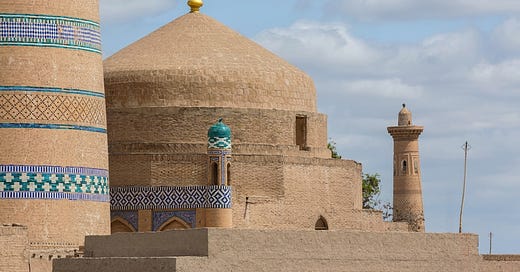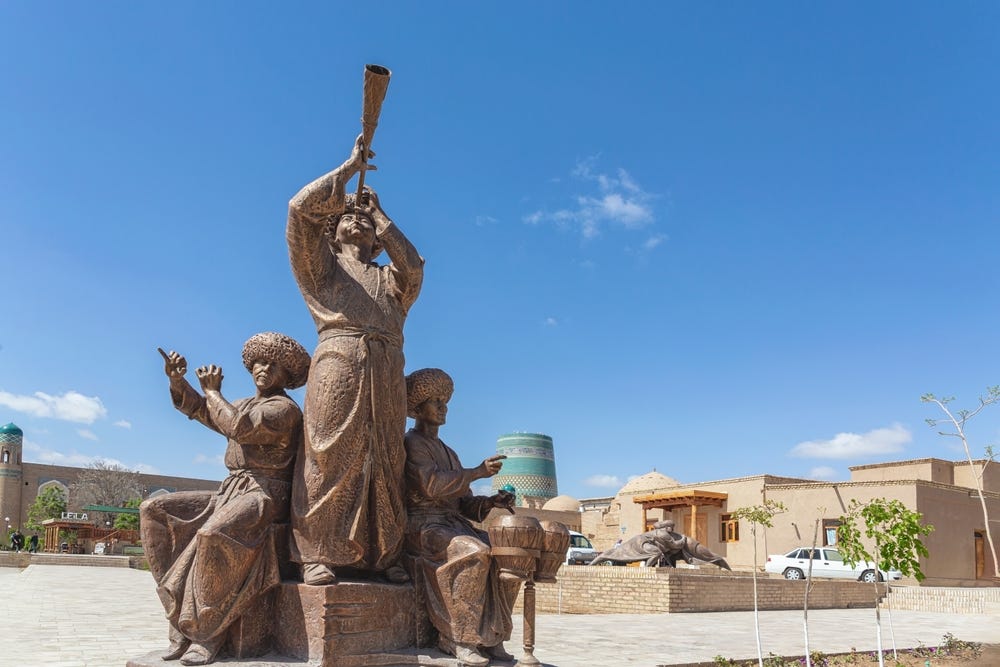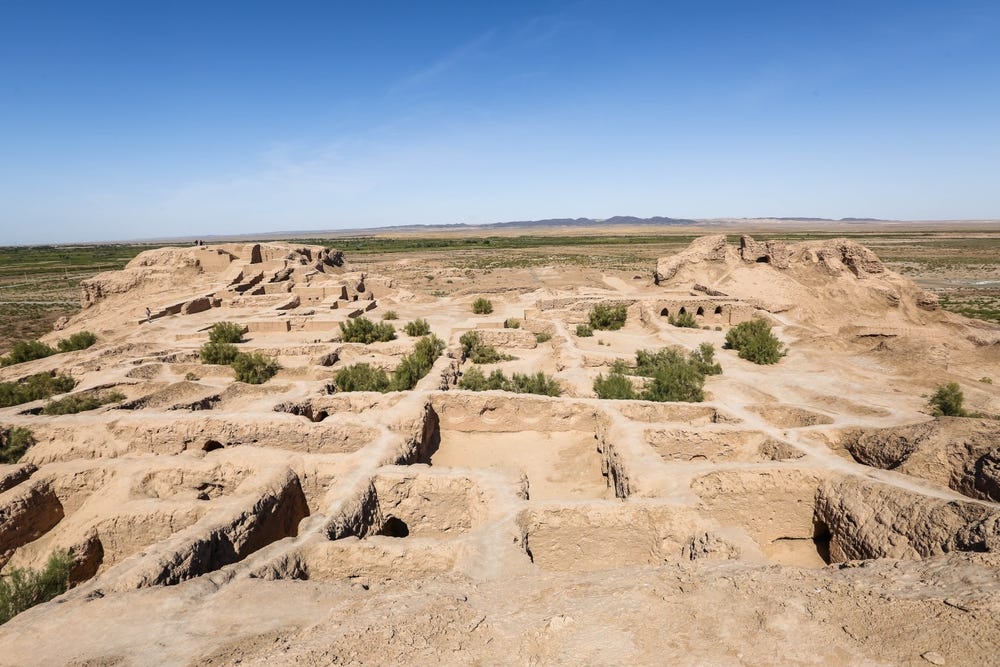Unearthing Uzbekistan's Forgotten Genius: The Lost Civilization of Khwarazm
A new piece by S. Frederick Starr for the World Society for the Study, Preservation and Popularization of the Cultural Legacy of Uzbekistan
In the heart of Central Asia lies a hidden treasure trove of history - the ancient civilization of Khwarazm. While tourists flock to the well-known wonders of Samarkand and Bukhara, a lesser-known realm of brilliance awaits rediscovery. From this forgotten oasis emerged two of history's greatest minds: al-Khwarazmi, the father of algebra, and Biruni, a polymath who measured the Earth with astonishing accuracy. Yet their homeland, a beacon of innovation for over four centuries, was violently erased from memory.
Join us as we peel back the layers of time to explore the lost world that gave birth to these intellectual giants. Prepare to be amazed by a tale of cultural richness, scientific achievement, and the urgent need to reclaim this vital piece of Uzbekistan's heritage.
Khwarazm
S. Frederick Starr
Uzbek and foreign tourists alike make sure to visit awesome Samarkand, stately Bukhara, and staunchly walled Khiva. More and more visitors also seek out the astonishing antiquities of Uzbekistan’s other historic regions, including Kashkadarya, Sukhandarya, Tashkent, and Fergana. But I want to draw your attention to one of Uzbekistan’s richest and less explored centers of ancient culture, Khwarazm, or Khorezm as it came to be known during the period of Russian rule in Uzbekistan. This region is a low-lying oasis bounded by the Aral Sea to the north, the Kyzylkum desert to the east, the Karakum desert to the south, and by the Ustyurt plateau to the west. While most of its territory falls within modern-day Uzbekistan, a smaller part lies across the border in Turkmenistan. A deepened understanding of the civilization that flourished there should be an essential component of any present-day effort to reclaim Uzbekistan’s rich cultural heritage.
Ahah, you say. But wasn’t Khiva the capital of Khorezm, and hasn’t the Uzbek government restored that city’s fortifications and major monuments and made it a major tourist venue? This is true, of course. The Khanate of Khiva was indeed the capital of what was often called Urgench or Khwarazm, but that was only from the 16th to the 20th centuries Prior to that, dating back to the year 1077, Khiva belonged to the Turko-Persianate Khwarazmian Empire which, from Khiva and its other capital at Kunya Urgench, in what is now Turkmenistan, they ruled much of Central Asia and projected their power deep into Afghanistan. Their capital impressed all who visited it, with the thirteenth century Syrian traveller Yaqut al-Hamawi, who lived there in the years 1219-1220, commenting that he “had never seen a city more wealthy and beautiful than Gurganj.”1 But for all its wealth and power, the cultural achievements of the medieval Khwarazmian empire were modest compared with those of its more ancient predecessors.
The brilliant civilization in Khwarazm that is my concern preceded these late medieval empires by a millennium. having been founded in the year 305. Long before the region’s independence, it rulers had sent troops with the Persian king Xerxes to fight Greece, and its local rulers had later offered friendship to the invading Alexander the Great. But it was only in the year 305 that Khwarazm, already a region with an ancient past, declared its independence from Sassanian Iran and founded a multi-cultural polity known to history as the Afrighids, who were Persianate by ethnicity and Zoroastrians in their religion. From time to time over the centuries the Afrighid rulers fell under the suzerainty of various regional powers, but weak external control and sheer distance from the major power centers left Khwarazmians free to develop in their own distinctive way.
In fields as diverse as architecture, art, literature, mathematics, architecture, and religion the Afrighids proved to be innovators of the first order. Thanks to trade, they were in touch with much of the known world, with the result that their coinage resembled that of the Kushan rulers in Afghanistan and some of their sculpture revealed Greek influences. However, they developed and maintained their own distinctive culture, which thrived down to the Arab conquest of Khwarazm in the year 712. After a century’s lapse, the shahs of Khwarazm, who were by then Muslim, arose on the same territory but moved the capital to Kath, near the present-day Uzbek town of Beruni. Kath was a booming, cosmopolitan, and chaotic center of trade and culture until the entire metropolis was swallowed by the flooding waters of the Amu Darya.
As these rulers laid claim to the Afrighids’ cultural glory, Kath became the birthplace of two of the world’s great thinkers, the mathematician al-Khwarazmi and the polymath Biruni. It is no exaggeration to say that few people before or since have done as much as these two men to advance our understanding of our world, the universe, and of the mathematics needed to study them. Together, they epitomize one of the most glorious moments in the culture of all Central Asia and the world.
Al-Khwarazmi reinvented and defined the field of algebra, measured a degree of longitude to within two kilometers of the modern figure, and persuaded the world that the Indian numbering system –which we mistakenly call Arabic--was superior to all others. Although he is largely forgotten today, we nonetheless salute al-Khwarazmi every time we use the word “algorithm,” which is simply a corruption of his name. As to Biruni, among scores of other achievements he measured the earth and moon more accurately than anyone down to the seventeenth century and hypothesized the existence of North and South America as inhabited continents.
Biruni (973-1050) has special importance for our enquiry today because—amidst his countless other learned projects-- he researched and wrote a detailed history of Khwarazm extending back to the year 305 AD. It is a great tragedy that not one copy of Biruni’s great history has come down to us. In brief mentions in his other writings, however, Biruni argued that the Persianate Afrighid dynasty, which ruled Khwarazm for seven centuries down to the Arab conquest, had developed a truly remarkable literary and scientific culture. He speaks of whole libraries of their poetry and other literary works, of scientific studies, and philosophical disquisitions.
All of this went up in flames during the Arab conquest in the year 712. Biruni’s chilling report states that the Muslim general Qutaiba bin Muslim “swiftly killed whoever wrote in the Khwarazmian language and knew of the Khwarazmian heritage, history, and culture. He then killed all their Zoroastrian priests and burned and destroyed their books, until only the illiterate [part of the population] remained, and hence the region's history was mostly forgotten.” In spite of this gruesome assault, Zoroastrianism managed to survive for another century until the Khwarazmian rulers finally converted to Islam and the region’s Zoroastrians either followed suit or fled. The Khwarazmian language fared no better than its traditional religion. So thorough was Qutaiba bin Muslim’s destruction that only a few hundred words of the old Khwarazmian language are known to us today.
The appearance of any mathematical or astronomical genius of the highest order is an extremely rare occurrence. But for two to emerge from the same place, and for that place to be the capital of a remote culture whose very existence is unknown to all but a few scholars and intrepid tourists, is almost unheard of. It requires an explanation.
The Russian scholar Boris Vasilevich Andrianov brought to light one factor that may have prompted al-Khrarazmi to write his Algebra, namely, the entire region’s dependence on irrigated agriculture.2 This technology called for careful diversions of water from field to field, which in turn required what was in reality an algebraic understanding of relative masses and volumes. A similar understanding of quantities and their division according to complex ratios was called for when different types of property had to be divided into among heirs after a rich man’s death. Such problems challenged al-Khrarazmi to elaborate a system for resolving them became the very foundation upon which the society’s wealth rested.
So what do we actually know of Khwarazm’s glory days? Two scholars, one Russian and the other English, have led the international effort to recover this lost golden age. From 1937 to 1969 the Soviet scholar Sergei Pavlovich Tolstov headed the Khwarazmian Expedition, which catalogued some fifty Khwarazmian cities and fortresses. By today’s standards Tolstov’s archaeology was primitive, but he succeeded in putting ancient Khwarazm back onto the map by locating and excavating formidable fortresses, Zoroastrian temples, brilliant frescoes with scenes from Indian mythology, and even a throne room.3 Tolstov presented his findings in countless articles and two books that should be the inevitable starting point for any fresh explorations.4 The second scholar whose labors recovered the memory of Khwarazm was the great English historian Clifford Edmund Bosworth, who exhaustively mined the surviving literary sources from all eras and languages and presented his findings in a series of brilliant studies that vastly expanding the primary literature on Khwarazm and even corrected Biruni on several points.5
So what do we not know about the civilization that culminated in al-Khwarazmi and Biruni? Sadly, so much has been destroyed that the list of unknowns and of what the American Donald Rumsfeld called “unknown unknowns” is infinite. For example, even the casual visitor to the lordly Topraq Qala, stepping on countless fragments of ancient pottery, is bound to want to know more about the community of traders, tradesmen and common workers that surrounded the fortress or Ark, what industries they pursued, and even about their genetic makeup. If these fortresses conform to the same pattern as Bukhara, Samarkand and other ancient Central Asian centers, we should expect to find outer walls far beyond the forts themselves, that were erected to protect the vast areas where the public lived and worked. If fragments of these walls are found they may indicate far larger populations than we have assumed to now.
Turning to more specific issues, will we ever see a virtual reconstruction of the impressive colonnaded structure that was excavated at Akchakhan Qala, one that will enable us to identify that edifice’s place in the history of architecture? And why are there three fortresses at Ayaz Qala? Were they built successively and, if so, to protect against which enemies? Or did they coexist in time, and represent some complex polity of which we know nothing? And, finally, the rediscovered throne room at Qyzyl Qala prompts us to ask if it existed because that site was the main capital of ancient Khwarazm or, rather, because Qyzyl Qala was merely the seat of one of several principalities and minor kingdoms in a more decentralized state or federation?
The number and range of questions that are unanswered is vast and profoundly challenging. To cite but one example, the beautifully executed frescoes uncovered at several forts reveal clear evidence of contact not only with Indian religion and art but also with Indian mathematics, so essential to al-Khwarazmi’s work.6 How, we must ask, did these influences find their way across the 113,000 kilometers from India to what is now western Uzbekistan?
These and countless other questions about the lost civilization of ancient Khwarazm remain to be answered and, in many case, even to be asked. Stated bluntly, we have barely reached the starting line of this enquiry. However, the quest is worth pursuing for at least three reasons. First, as was noted above, such investigations are essential in order to shed light on the rich and complex cultural milieu that gave rise to our two mathematical and scientific geniuses, al-Khwarazmi and Biruni. Second, by adding the Khrawazmians to the rich panoply of cultures that constitute historic Uzbekistan and Central Asia as a whole, we will enrich and deepen our understanding of one of the world’s seminal and most productive cultural and intellectual regions.
And, third, at a time when Uzbekistan and its neighbors are all seeking to deepen national education and expand cultural tourism, it is essential that up-to-date and accessible books, pamphlets, and videos be available to visitors from Uzbekistan itself and from the world at large. It is not enough for tourists to gaze at the walls of Kyzyl Kala and to mutter about the fragility and transitory nature of all human endeavors. They must also be given the opportunity to learn more deeply about what they have seen, and to return to their vans or tour buses better informed and with published guides that will enable them to explore further and on their own this and other neglected gems of Central Asian civilization.
Yaqut al-Hamawi , Mudjam al- buldan , (Farsi translation by A.N. Monzavi), Tehran, 2001, II p. 36.
Boris Vasilevich Andrianov, Drevnie orositelnye sistemy priaralya, Moscow, 19__, translated by Simone Mantellini as Irrigation Systems of The Aral Sea Area. The History, Origin, and Development of Irrigated Agriculture, American School of Prehistoric Research Monographs, uploaded 2024.
V. Altman, “Ancient Khorezmian Civilization in the Light of the Latest Archaeological Discoveries (1937-1945),” Journal of the American Oriental Society, vol. 67, No. 2 (Apr. - Jun., 1947), pp. 81-85.
Drevnii Khorezm, Moscow, 1948, and Po sledam drenekhorezemskoi tsivilizatsii, Moscow, 1948; see also his earlier Po drevnim del’tcam Oksa i Yaksarta, reprint, Moscow, 1961.
Summarized in C.E. Bosworth, "Ḵh̲warazm," Encyclopaedia of Islam, Leiden, 1978, IV, pp.1061 ff.
F. Kidd, M. Negus-Cleary, V.N. Yagodin, A. Betts, E. Baker-Brite, “Ancient Chorasmian Mural Art,” Bulletin of the Asia Institute, 2004, ISSN 0890-4464.





